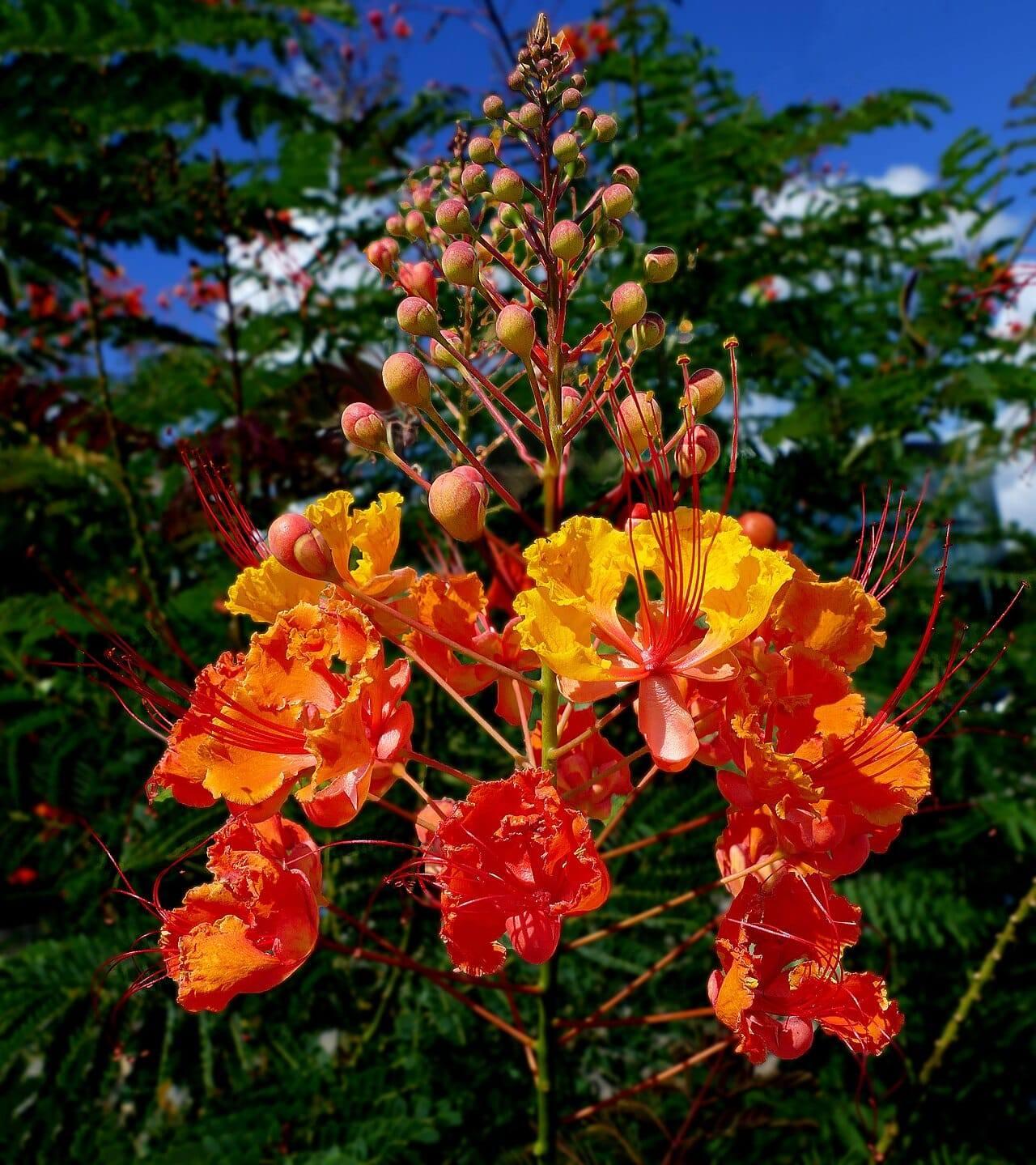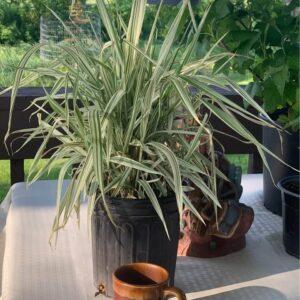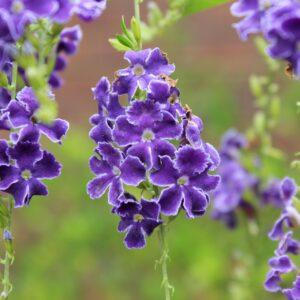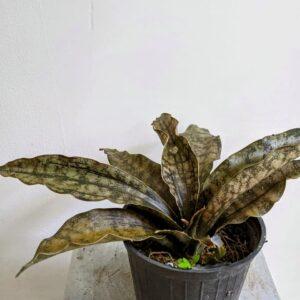Radhachura (Peacock Flower Tree) – A Tropical Explosion of Sunlight
The Peacock Flower, sometimes referred to as Radhachura, is a quick-growing decorative tree that is well-known for its vivid yellow blooms and fine, fern-like leaves. Commonly known by its scientific name, Peltophorum pterocarpum, it’s also referred to as Copperpod, Yellow Flame Tree, and Yellow Poinciana. Radhachura, which is native to tropical Asia and extensively farmed throughout India, Southeast Asia, and other warm climates, is valued for its beautiful blossoms, broad canopy, and capacity to flourish with little maintenance.
Radhachura is frequently grown in big parks and gardens as an avenue tree or for shade. Its clusters of bright yellow flowers that resemble a peacock’s flamboyant display create a stunning visual, earning it the moniker “”Peacock Flowering Plant.””
Overview
Scientific name: Peltophorum pterocarpum
Common names: Peacock Flower Tree, Copperpod, Yellow Flame Tree, Radhachura
Deciduous tree species
Between 10 and 15 meters tall (can grow taller in favorable conditions)
Bright yellow blooms in lengthy racemes that cascade down
late spring to early monsoon (April to July) is the blooming season.
Foliage: Bipinnate, fine-textured, resembling delicate feathers
💧 Watering Schedule
After it has become established, Radhachura is just somewhat drought-resistant, but it likes regular moisture during its development.
Young trees: During the first 1–2 years, water 2–3 times a week.
Established trees: During dry spells, water once a week. The majority of the time, natural rainfall is enough during wet seasons.
Prevent waterlogging: Make sure the planting location has soil that drains well since standing water can harm roots.
Mulching: Applying mulch around the base aids in weed control and helps maintain soil moisture.
Temperature and Climate
The tropical and subtropical climate of Radhachura is ideal. It prospers in warm weather and is able to withstand sporadic dry spells.
Best temperature range: 20°C to 35°C (68°F to 95°F)
Frost sensitivity: not frost-tolerant. In locations where frost or cold spells are common, it should be avoided or protected.
Light requirements: Full sun is necessary for profuse blooms. Direct sunshine for at least six to eight hours daily is perfect.
Requirements for Soil and Fertilizer
As long as there is adequate drainage, Radhachura may be grown in a variety of soils, including sandy and loamy ones.
Ideal soil pH range: between neutral and somewhat acidic (6.0–7.5)
Soil quality: At the beginning of the planting process, improve the planting site’s soil quality by adding organic compost.
Schedule for Fertilizers:
At planting: Mix well-rotted manure or organic compost into the soil.
Annually: In early spring, use a well-balanced fertilizer (10-10-10 or 12-12-12 NPK).
Addition: Every 6–8 weeks throughout the growing season, you can improve blooms and general health by adding compost tea or liquid seaweed.
Maintenance and trimming
Once established, Radhachura needs very little care:
Pruning: To promote a robust structure and get rid of any dead or weak branches, prune lightly in late winter or early spring.
Leaf litter: The tree drops its leaves and pods at certain times of the year. If planted close to pathways or patios, frequent cleaning is advised.
Its innate umbrella-like shape provides great shade, but its canopy may be molded as necessary to regulate its spread.
Techniques for Propagation
Seeds are the most widely used and successful method for propagating Radhachura, although stem cuttings can also be used.
From seeds:
Once dry on the tree, gather ripe pods.
To soften the tough outer shell, soak the seeds in warm water for 12–24 hours.
Plant in nursery pots or bags filled with well-draining soil.
In most cases, germination takes place over 10 to 15 days.
When seedlings are between one and two feet tall, transplant them.
From cuttings:
Rooting hormone can be used to root semi-hardwood cuttings in a warm, humid environment.
While less reliable than seed propagation, it is feasible in regulated environments.
🌼 Ideas for landscaping and applications
Shade Tree: Because of its broad canopy, it’s perfect for roadside planting, parks, and campuses.
Attractive: The brilliant yellow blossoms draw bees and butterflies, bringing life to any yard.
Companion planting: Pair with red blooming trees, such as Krishnachura (Delonix regia), for a striking color contrast. In Indian landscapes, this is frequently referred to as a “”Radhachura-Krishnachura”” pair.
Erosion control: Its roots assist in holding soil on slopes or embankments.
The Conclusion
The magnificent and low-maintenance radhachura tree adds vibrant golden-yellow blooms and abundant greenery to tropical gardens. It is a great option for anyone searching for a gorgeous blooming tree that doesn’t need a lot of care because it uses very little water once it’s established, tolerates heat, and resists pests.
Radhachura provides beauty, shade, and longevity in one elegant package, making it a great option for planting a tropical garden or lining a driveway with summer color.”
Radhachura – Peacock flowering plant
₨599.00
The beautiful decorative shrub known as Radhachura, the Peacock Flowering Plant, or Caesalpinia pulcherrima is distinguished by its brilliant, fiery blooms in hues of red, orange, and yellow. Its exotic appearance and fern-like foliage are what make it so popular. The name **Dwarf Poinciana** is frequently used for it. Radhachura, which is native to tropical climates, produces a lot of flowers in the warmer months, drawing in hummingbirds and butterflies. This rapidly expanding species flourishes in well-drained soil and direct sunlight. Once established, it can withstand drought and serves as a lovely standalone focal point, border, or hedge. Gardens take on a tropical, celebratory mood thanks to its showy blossoms and feathery leaves.





Reviews
There are no reviews yet.